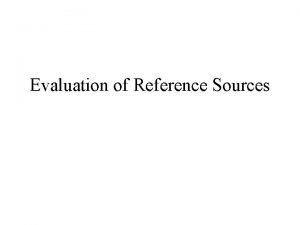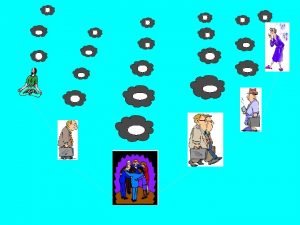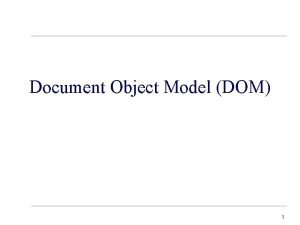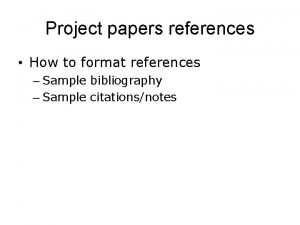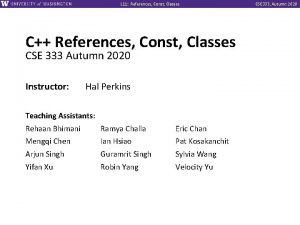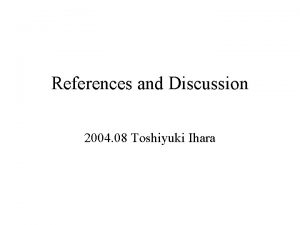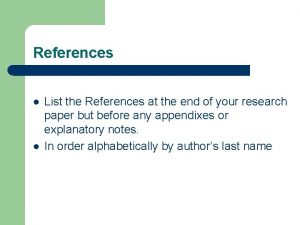Working with References 1 References n n n

















- Slides: 17

Working with References 1

References n n n Every object variable is a reference to an object Also true when an object is passed as an argument When the object is used, the reference is “followed” to find the actual object 2

null References n A variable that does not currently point to anything is called a null reference q n // name is null We can check if a variable contains a null reference using the null identifier q n e. g. String name; e. g. if(name != null){…} Java doesn’t like null references q … but they can be hard to find for instance variables 3

null References n Look at Student. Reference. Test. java n Note: q q q Compiler catches null reference in the local variable null references are never allowed in local variables … but the compiler can not catch the null reference in the instance variables n it doesn’t know “where the reference has been” 4

null References n Three situations can arise: q q q local variable null … compile error null reference printed/passed … this can be missed initially null reference used to call a method … this gets a null pointer exception n null objects don’t have defined methods 5

The Picture Student s 1 = new Student(300012345, “uid”); s 1. set. First. Name(“Sam”); s 1 Student -----student. Number = 300012345 first. Name = “Sam” last. Name = null. . . 6

Aliases Student s 1 = new Student(300012345, “uid”); s 1. set. First. Name(“Sam”); Student s 2 = s 1; s 1 s 2 Student -----student. Number = 300012345 first. Name = “Sam” last. Name = null. . . 7

Aliases s 2. set. First. Name(“Pat”); System. out. println(s 1. get. First. Name()); \prints “Pat” s 1 s 2 Student -----student. Number = 300012345 first. Name = “Pat” last. Name = null. . . 8

Copying n n n If we really do want to copy an object, it has to be done manually Create a new instance, and copy the relevant data over Not an issue if there are no methods that change the object… i. e. for immutable objects q e. g. String objects 9

Immutable Object Reference n For strings: String s 1 = "Sam"; String s 2 = s 1; s 2 = "Pat"; System. out. println(s 1); System. out. println(s 2); 10

Changeable Object Reference n For students: Student s 1 = new Student(1111, "u 1"); s 1. set. First. Name("Sam"); Student s 2 = s 1; s 2. set. First. Name("Pat"); System. out. println(s 1. get. First. Name()); System. out. println(s 2. get. First. Name()); 11

The clone Method n Many classes contain a clone() method q q n this returns a copy of the object i. e. a new object with the relevant info copied e. g. public Student clone() { Student s = new Student(student. Number, userid); //… copy the rest of the relevant data return s; } 12

Equality and References n Compare references not objects Student s 1 = Student s 2 = Student s 3 = \now s 1==s 3 new Student(300012345, ”uid”); s 1; and s 1!=s 2 Student -----300012345 “uid” s 1 s 2 Student -----300012345 “uid” s 3 13

The equals Method n Many classes define an equals method n “equal” depends on the class For students: n public boolean equals(Student s) { return student. Number == s. student. Number; } 14

The compare. To Method n n Used for more general comparison: <, ==, > a. compare. To(b) should return: q q q n Used by the built-in sorts q n a negative int if a<b 0 if a==b a positive int if a>b one call to compare. To gives all the info needed about the relative order For students… not 100% clear q q student. Number? But not all objects are sortable 15

The this Reference n n It is often convenient/necessary to explicitly refer to members of the current object q e. g. student. Number == s. student. Number q This can be confusing… same variable name The special identifier this refers to the object that the code is defining q e. g. this. student. Number == s. student. Number q This is more clear 16

Using this in Constructors n In constructors, we need to pass a formal parameter to fill a data member public Student(long stunum, …){ student. Number = stunum; … } n Using this can clarify the situation: public Student(long student. Number, …){ this. student. Number = student. Number; … } 17
 Hot working and cold working
Hot working and cold working Hot working and cold working difference
Hot working and cold working difference Machining operations
Machining operations Working smart vs working hard
Working smart vs working hard Contoh hot working
Contoh hot working References of procurement
References of procurement Lister
Lister References of solar energy
References of solar energy Swedbank internetbanka vietējie maksājumi
Swedbank internetbanka vietējie maksājumi Velocite movie riptide
Velocite movie riptide Inyage
Inyage Job analysis references
Job analysis references References of climate change
References of climate change Difference between reference and bibliography
Difference between reference and bibliography Segregation of hazardous waste
Segregation of hazardous waste What is a bibliography
What is a bibliography Personal profile statement
Personal profile statement Criteria for evaluation of reference sources
Criteria for evaluation of reference sources

















